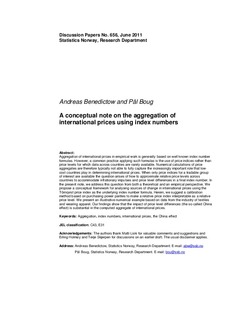A conceptual note on the aggregation of international prices using index numbers
Working paper

View/
Date
2011Metadata
Show full item recordCollections
- Discussion Papers [1003]
Abstract
Abstract:
Aggregation of international prices in empirical work is generally based on well known index number formulas. However, a common practice applying such formulas is the use of price indices rather than price levels for which data across countries are rarely available. Numerical calculations of price aggregates are therefore typically not able to fully capture the increasingly important role that low-cost countries play in determining international prices. When only price indices for a tradable group of interest are available the question arises of how to approximate relative price levels across countries to accommodate inflationary impulses and price level differences in a final index number. In the present note, we address this question from both a theoretical and an empirical perspective. We propose a conceptual framework for analysing sources of change in international prices using the Törnqvist price index as the underlying index number formula. Herein, we suggest a calibration method based on purchasing power parities to make a relative price index interpretable as a relative price level. We present an illustrative numerical example based on data from the industry of textiles and wearing apparel. Our findings show that the impact of price level differences (the so-called China effect) is substantial in the computed aggregate of international prices.
Keywords: Aggregation, index numbers, international prices, the China effect
Description
Abstracts with downloadable Discussion Papers
in PDF are available on the Internet:
http://www.ssb.no